NRSG258: Case Study: Nursing Care for a Patient Post-Surgery
VerifiedAdded on 2022/09/12
|12
|2972
|12
Case Study
AI Summary
This case study from NRSG 258 focuses on an 82-year-old male patient who underwent bowel resection surgery due to a malignant mass and presents with multiple comorbidities including cardiac arrest, gout, type two diabetes mellitus, hypertension and obesity. The patient experiences post-operative complications such as nausea, vomiting, and abdominal pain, along with pre-existing conditions like hypertension and potential bowel obstruction. The case study addresses the biopsychosocial, spiritual, and cultural impacts of the surgery on the patient, detailing the patient's symptoms, including a high respiratory rate, elevated blood pressure, and low urine output. The analysis outlines nursing interventions such as pain management through alternative methods like pain-controlled anesthesia, managing nausea and vomiting with antiemetics, addressing dehydration and electrolyte imbalances with fluid therapy, and supporting the patient's nutritional needs. The document also discusses the pharmacological treatments, including antiemetics for bowel obstruction and antihypertensives for high blood pressure, while highlighting the nursing implications of each drug. The case study aims to provide a comprehensive understanding of the patient's condition and the nursing care required to ensure a positive outcome.
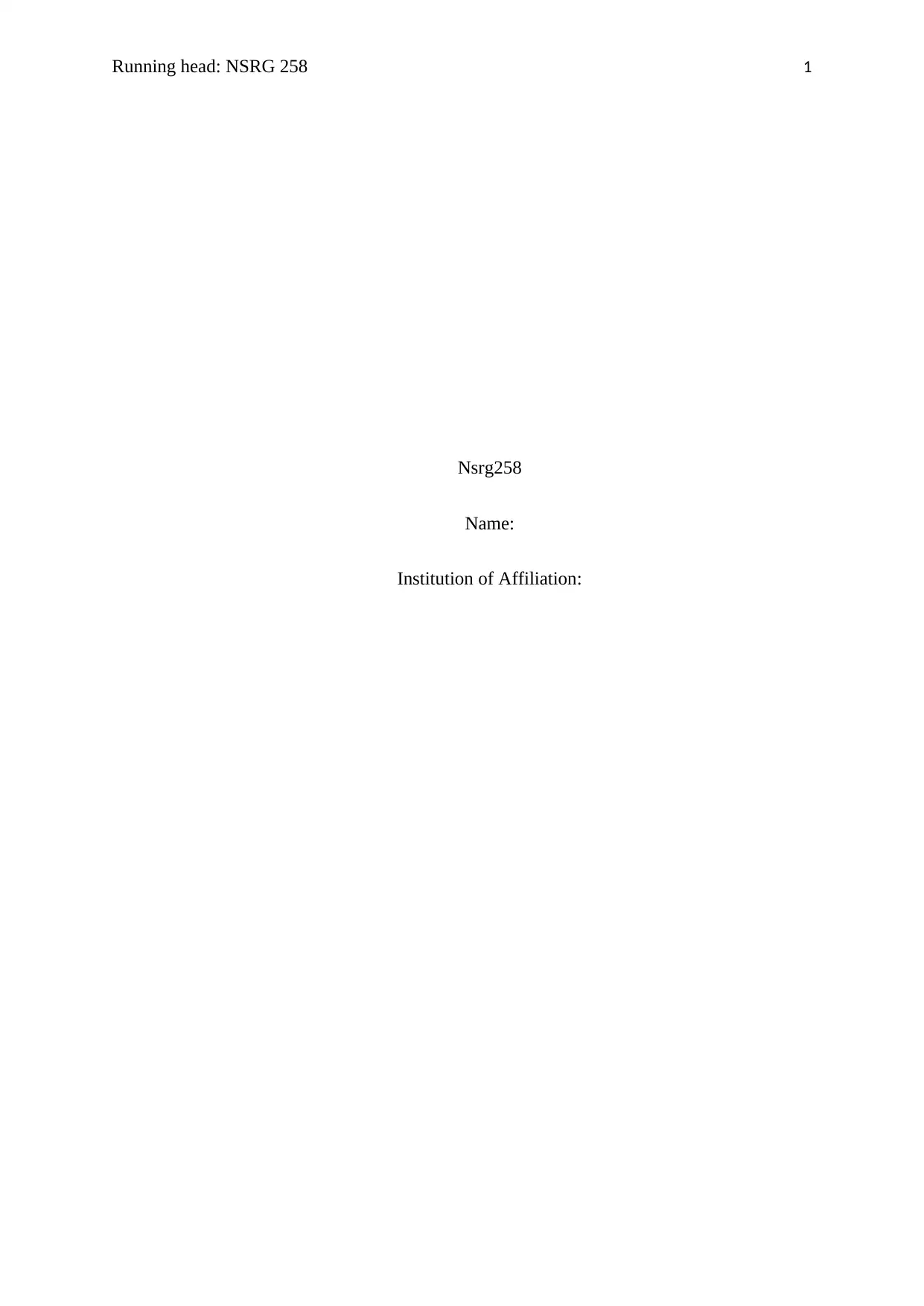
Running head: NSRG 258 1
Nsrg258
Name:
Institution of Affiliation:
Nsrg258
Name:
Institution of Affiliation:
Paraphrase This Document
Need a fresh take? Get an instant paraphrase of this document with our AI Paraphraser
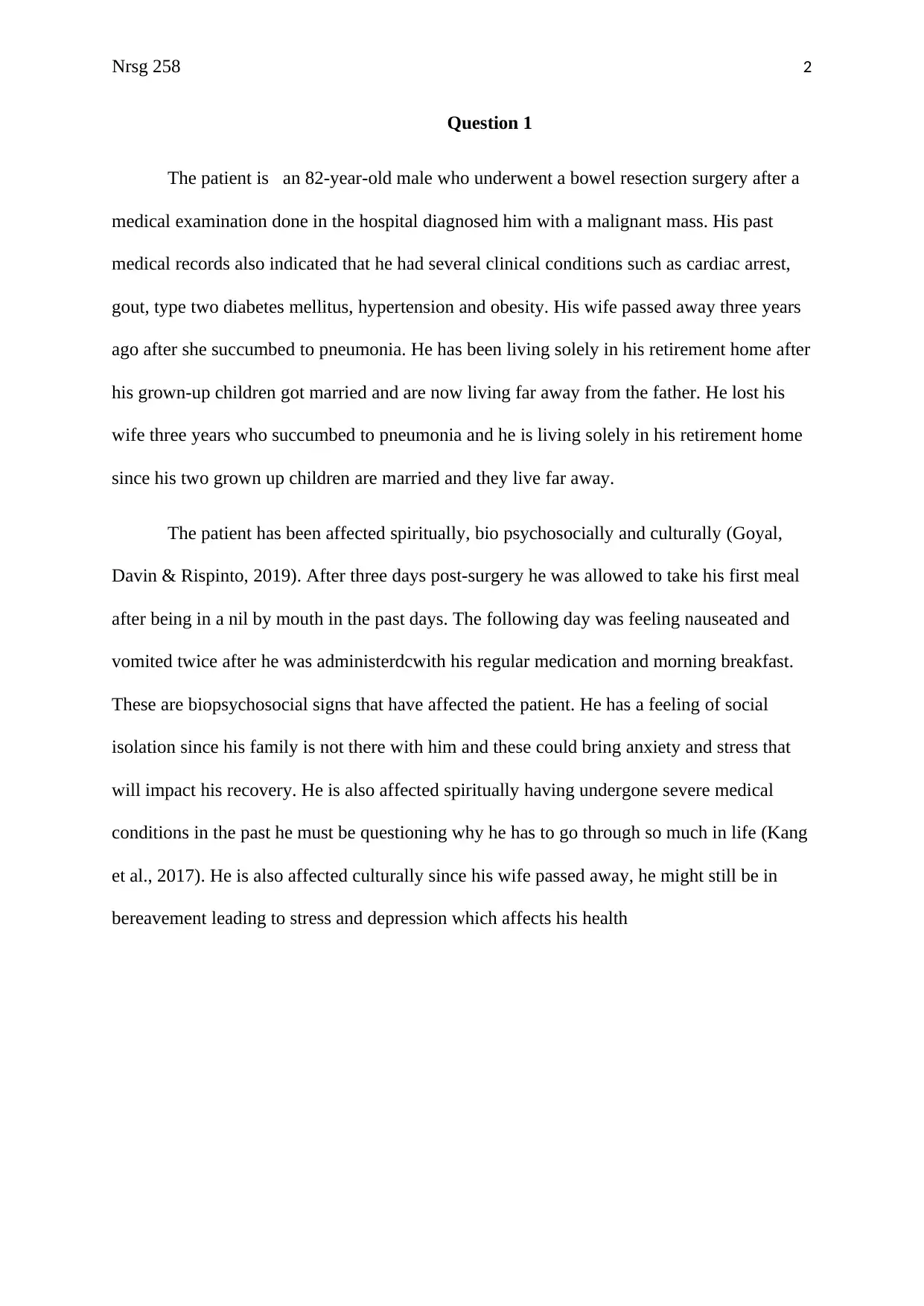
Nrsg 258 2
Question 1
The patient is an 82-year-old male who underwent a bowel resection surgery after a
medical examination done in the hospital diagnosed him with a malignant mass. His past
medical records also indicated that he had several clinical conditions such as cardiac arrest,
gout, type two diabetes mellitus, hypertension and obesity. His wife passed away three years
ago after she succumbed to pneumonia. He has been living solely in his retirement home after
his grown-up children got married and are now living far away from the father. He lost his
wife three years who succumbed to pneumonia and he is living solely in his retirement home
since his two grown up children are married and they live far away.
The patient has been affected spiritually, bio psychosocially and culturally (Goyal,
Davin & Rispinto, 2019). After three days post-surgery he was allowed to take his first meal
after being in a nil by mouth in the past days. The following day was feeling nauseated and
vomited twice after he was administerdcwith his regular medication and morning breakfast.
These are biopsychosocial signs that have affected the patient. He has a feeling of social
isolation since his family is not there with him and these could bring anxiety and stress that
will impact his recovery. He is also affected spiritually having undergone severe medical
conditions in the past he must be questioning why he has to go through so much in life (Kang
et al., 2017). He is also affected culturally since his wife passed away, he might still be in
bereavement leading to stress and depression which affects his health
Question 1
The patient is an 82-year-old male who underwent a bowel resection surgery after a
medical examination done in the hospital diagnosed him with a malignant mass. His past
medical records also indicated that he had several clinical conditions such as cardiac arrest,
gout, type two diabetes mellitus, hypertension and obesity. His wife passed away three years
ago after she succumbed to pneumonia. He has been living solely in his retirement home after
his grown-up children got married and are now living far away from the father. He lost his
wife three years who succumbed to pneumonia and he is living solely in his retirement home
since his two grown up children are married and they live far away.
The patient has been affected spiritually, bio psychosocially and culturally (Goyal,
Davin & Rispinto, 2019). After three days post-surgery he was allowed to take his first meal
after being in a nil by mouth in the past days. The following day was feeling nauseated and
vomited twice after he was administerdcwith his regular medication and morning breakfast.
These are biopsychosocial signs that have affected the patient. He has a feeling of social
isolation since his family is not there with him and these could bring anxiety and stress that
will impact his recovery. He is also affected spiritually having undergone severe medical
conditions in the past he must be questioning why he has to go through so much in life (Kang
et al., 2017). He is also affected culturally since his wife passed away, he might still be in
bereavement leading to stress and depression which affects his health
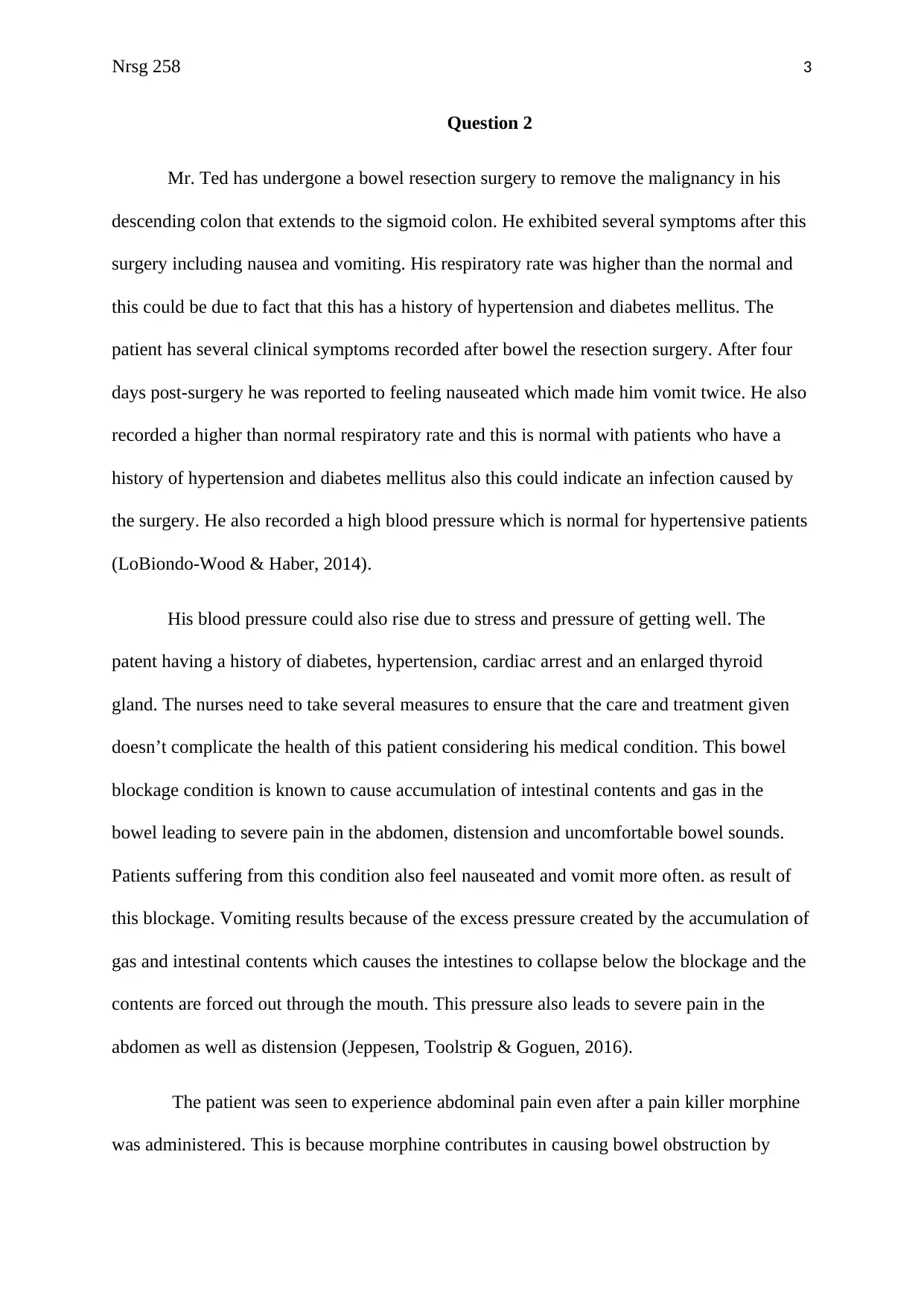
Nrsg 258 3
Question 2
Mr. Ted has undergone a bowel resection surgery to remove the malignancy in his
descending colon that extends to the sigmoid colon. He exhibited several symptoms after this
surgery including nausea and vomiting. His respiratory rate was higher than the normal and
this could be due to fact that this has a history of hypertension and diabetes mellitus. The
patient has several clinical symptoms recorded after bowel the resection surgery. After four
days post-surgery he was reported to feeling nauseated which made him vomit twice. He also
recorded a higher than normal respiratory rate and this is normal with patients who have a
history of hypertension and diabetes mellitus also this could indicate an infection caused by
the surgery. He also recorded a high blood pressure which is normal for hypertensive patients
(LoBiondo-Wood & Haber, 2014).
His blood pressure could also rise due to stress and pressure of getting well. The
patent having a history of diabetes, hypertension, cardiac arrest and an enlarged thyroid
gland. The nurses need to take several measures to ensure that the care and treatment given
doesn’t complicate the health of this patient considering his medical condition. This bowel
blockage condition is known to cause accumulation of intestinal contents and gas in the
bowel leading to severe pain in the abdomen, distension and uncomfortable bowel sounds.
Patients suffering from this condition also feel nauseated and vomit more often. as result of
this blockage. Vomiting results because of the excess pressure created by the accumulation of
gas and intestinal contents which causes the intestines to collapse below the blockage and the
contents are forced out through the mouth. This pressure also leads to severe pain in the
abdomen as well as distension (Jeppesen, Toolstrip & Goguen, 2016).
The patient was seen to experience abdominal pain even after a pain killer morphine
was administered. This is because morphine contributes in causing bowel obstruction by
Question 2
Mr. Ted has undergone a bowel resection surgery to remove the malignancy in his
descending colon that extends to the sigmoid colon. He exhibited several symptoms after this
surgery including nausea and vomiting. His respiratory rate was higher than the normal and
this could be due to fact that this has a history of hypertension and diabetes mellitus. The
patient has several clinical symptoms recorded after bowel the resection surgery. After four
days post-surgery he was reported to feeling nauseated which made him vomit twice. He also
recorded a higher than normal respiratory rate and this is normal with patients who have a
history of hypertension and diabetes mellitus also this could indicate an infection caused by
the surgery. He also recorded a high blood pressure which is normal for hypertensive patients
(LoBiondo-Wood & Haber, 2014).
His blood pressure could also rise due to stress and pressure of getting well. The
patent having a history of diabetes, hypertension, cardiac arrest and an enlarged thyroid
gland. The nurses need to take several measures to ensure that the care and treatment given
doesn’t complicate the health of this patient considering his medical condition. This bowel
blockage condition is known to cause accumulation of intestinal contents and gas in the
bowel leading to severe pain in the abdomen, distension and uncomfortable bowel sounds.
Patients suffering from this condition also feel nauseated and vomit more often. as result of
this blockage. Vomiting results because of the excess pressure created by the accumulation of
gas and intestinal contents which causes the intestines to collapse below the blockage and the
contents are forced out through the mouth. This pressure also leads to severe pain in the
abdomen as well as distension (Jeppesen, Toolstrip & Goguen, 2016).
The patient was seen to experience abdominal pain even after a pain killer morphine
was administered. This is because morphine contributes in causing bowel obstruction by
⊘ This is a preview!⊘
Do you want full access?
Subscribe today to unlock all pages.

Trusted by 1+ million students worldwide
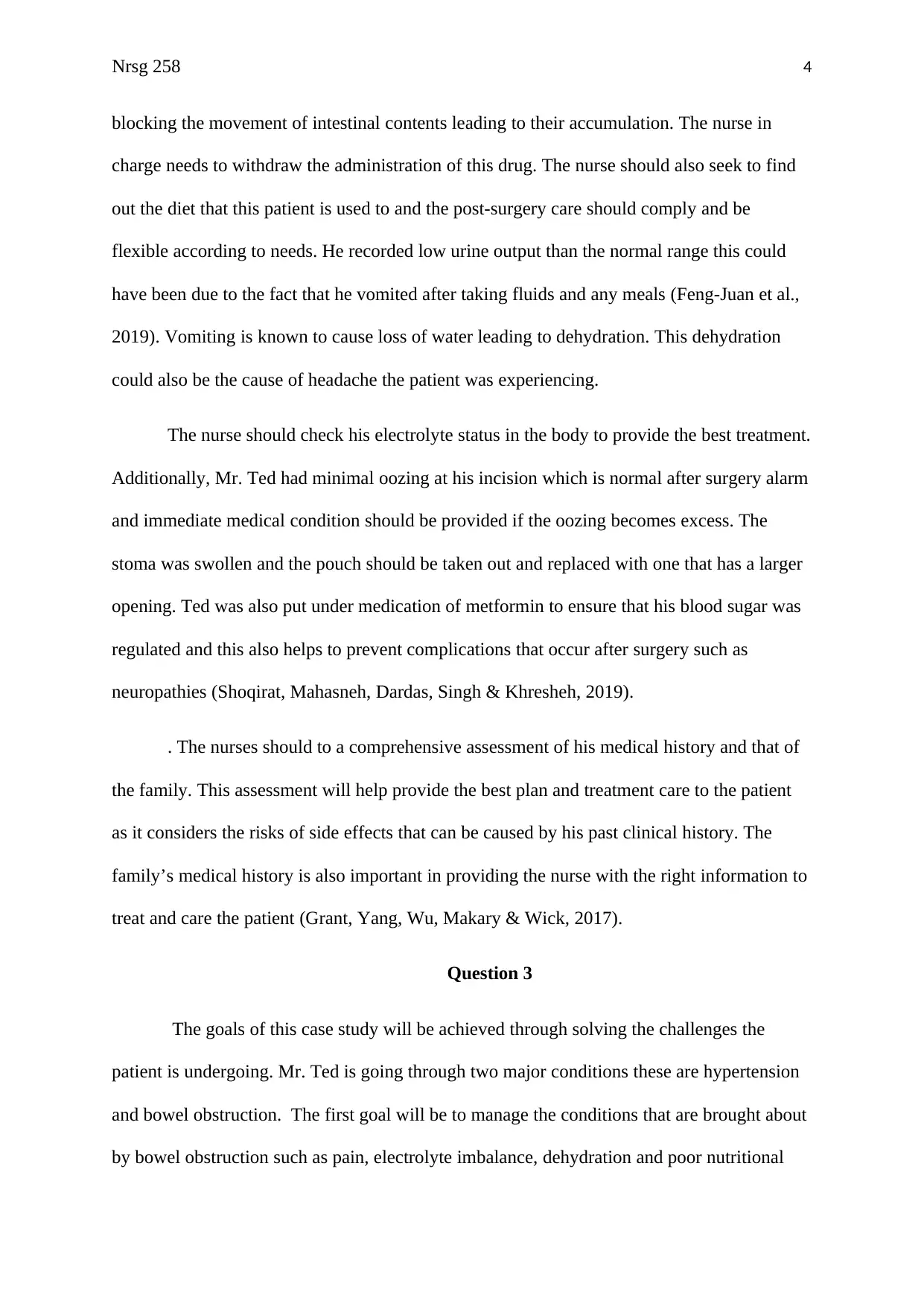
Nrsg 258 4
blocking the movement of intestinal contents leading to their accumulation. The nurse in
charge needs to withdraw the administration of this drug. The nurse should also seek to find
out the diet that this patient is used to and the post-surgery care should comply and be
flexible according to needs. He recorded low urine output than the normal range this could
have been due to the fact that he vomited after taking fluids and any meals (Feng-Juan et al.,
2019). Vomiting is known to cause loss of water leading to dehydration. This dehydration
could also be the cause of headache the patient was experiencing.
The nurse should check his electrolyte status in the body to provide the best treatment.
Additionally, Mr. Ted had minimal oozing at his incision which is normal after surgery alarm
and immediate medical condition should be provided if the oozing becomes excess. The
stoma was swollen and the pouch should be taken out and replaced with one that has a larger
opening. Ted was also put under medication of metformin to ensure that his blood sugar was
regulated and this also helps to prevent complications that occur after surgery such as
neuropathies (Shoqirat, Mahasneh, Dardas, Singh & Khresheh, 2019).
. The nurses should to a comprehensive assessment of his medical history and that of
the family. This assessment will help provide the best plan and treatment care to the patient
as it considers the risks of side effects that can be caused by his past clinical history. The
family’s medical history is also important in providing the nurse with the right information to
treat and care the patient (Grant, Yang, Wu, Makary & Wick, 2017).
Question 3
The goals of this case study will be achieved through solving the challenges the
patient is undergoing. Mr. Ted is going through two major conditions these are hypertension
and bowel obstruction. The first goal will be to manage the conditions that are brought about
by bowel obstruction such as pain, electrolyte imbalance, dehydration and poor nutritional
blocking the movement of intestinal contents leading to their accumulation. The nurse in
charge needs to withdraw the administration of this drug. The nurse should also seek to find
out the diet that this patient is used to and the post-surgery care should comply and be
flexible according to needs. He recorded low urine output than the normal range this could
have been due to the fact that he vomited after taking fluids and any meals (Feng-Juan et al.,
2019). Vomiting is known to cause loss of water leading to dehydration. This dehydration
could also be the cause of headache the patient was experiencing.
The nurse should check his electrolyte status in the body to provide the best treatment.
Additionally, Mr. Ted had minimal oozing at his incision which is normal after surgery alarm
and immediate medical condition should be provided if the oozing becomes excess. The
stoma was swollen and the pouch should be taken out and replaced with one that has a larger
opening. Ted was also put under medication of metformin to ensure that his blood sugar was
regulated and this also helps to prevent complications that occur after surgery such as
neuropathies (Shoqirat, Mahasneh, Dardas, Singh & Khresheh, 2019).
. The nurses should to a comprehensive assessment of his medical history and that of
the family. This assessment will help provide the best plan and treatment care to the patient
as it considers the risks of side effects that can be caused by his past clinical history. The
family’s medical history is also important in providing the nurse with the right information to
treat and care the patient (Grant, Yang, Wu, Makary & Wick, 2017).
Question 3
The goals of this case study will be achieved through solving the challenges the
patient is undergoing. Mr. Ted is going through two major conditions these are hypertension
and bowel obstruction. The first goal will be to manage the conditions that are brought about
by bowel obstruction such as pain, electrolyte imbalance, dehydration and poor nutritional
Paraphrase This Document
Need a fresh take? Get an instant paraphrase of this document with our AI Paraphraser
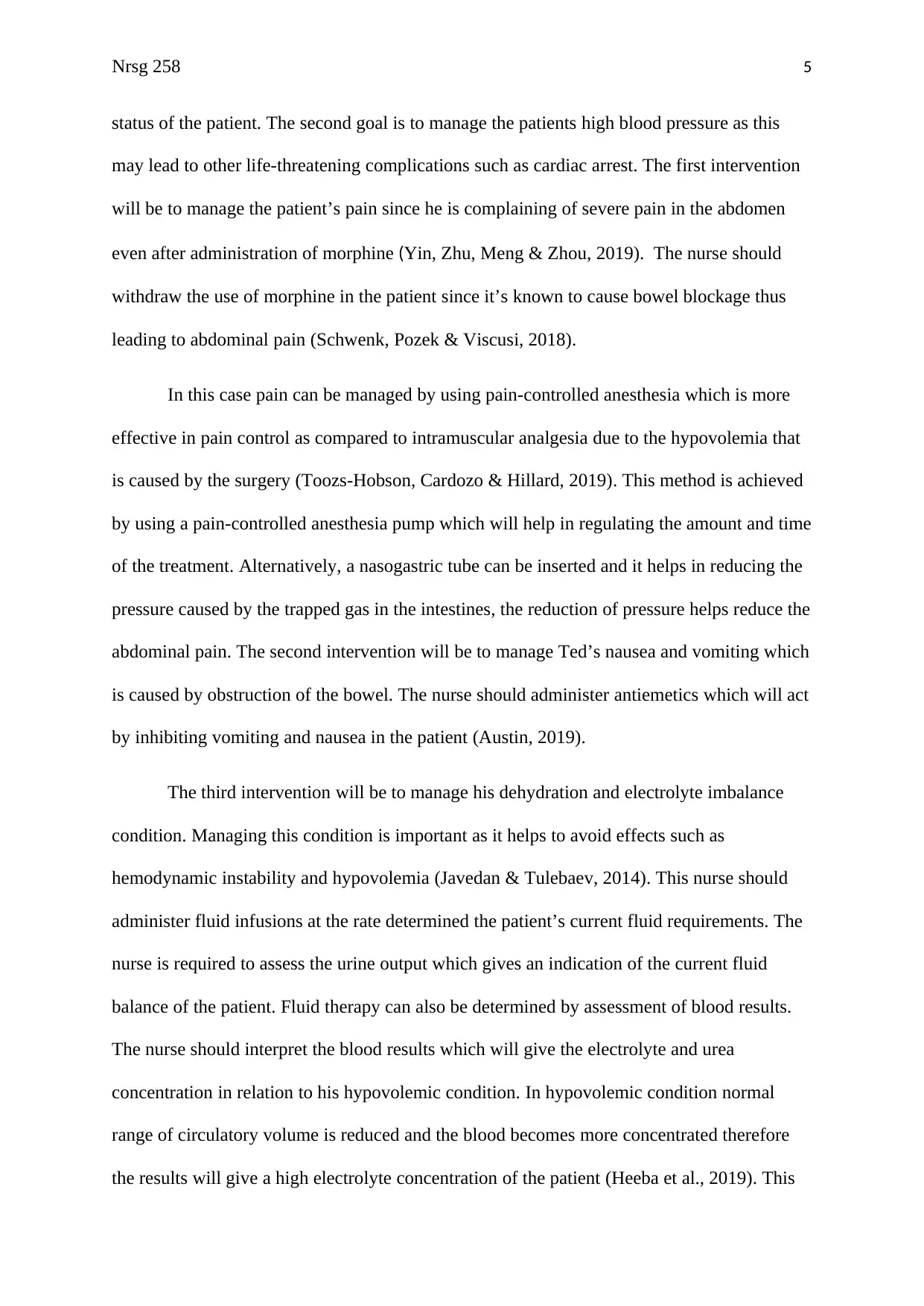
Nrsg 258 5
status of the patient. The second goal is to manage the patients high blood pressure as this
may lead to other life-threatening complications such as cardiac arrest. The first intervention
will be to manage the patient’s pain since he is complaining of severe pain in the abdomen
even after administration of morphine (Yin, Zhu, Meng & Zhou, 2019). The nurse should
withdraw the use of morphine in the patient since it’s known to cause bowel blockage thus
leading to abdominal pain (Schwenk, Pozek & Viscusi, 2018).
In this case pain can be managed by using pain-controlled anesthesia which is more
effective in pain control as compared to intramuscular analgesia due to the hypovolemia that
is caused by the surgery (Toozs-Hobson, Cardozo & Hillard, 2019). This method is achieved
by using a pain-controlled anesthesia pump which will help in regulating the amount and time
of the treatment. Alternatively, a nasogastric tube can be inserted and it helps in reducing the
pressure caused by the trapped gas in the intestines, the reduction of pressure helps reduce the
abdominal pain. The second intervention will be to manage Ted’s nausea and vomiting which
is caused by obstruction of the bowel. The nurse should administer antiemetics which will act
by inhibiting vomiting and nausea in the patient (Austin, 2019).
The third intervention will be to manage his dehydration and electrolyte imbalance
condition. Managing this condition is important as it helps to avoid effects such as
hemodynamic instability and hypovolemia (Javedan & Tulebaev, 2014). This nurse should
administer fluid infusions at the rate determined the patient’s current fluid requirements. The
nurse is required to assess the urine output which gives an indication of the current fluid
balance of the patient. Fluid therapy can also be determined by assessment of blood results.
The nurse should interpret the blood results which will give the electrolyte and urea
concentration in relation to his hypovolemic condition. In hypovolemic condition normal
range of circulatory volume is reduced and the blood becomes more concentrated therefore
the results will give a high electrolyte concentration of the patient (Heeba et al., 2019). This
status of the patient. The second goal is to manage the patients high blood pressure as this
may lead to other life-threatening complications such as cardiac arrest. The first intervention
will be to manage the patient’s pain since he is complaining of severe pain in the abdomen
even after administration of morphine (Yin, Zhu, Meng & Zhou, 2019). The nurse should
withdraw the use of morphine in the patient since it’s known to cause bowel blockage thus
leading to abdominal pain (Schwenk, Pozek & Viscusi, 2018).
In this case pain can be managed by using pain-controlled anesthesia which is more
effective in pain control as compared to intramuscular analgesia due to the hypovolemia that
is caused by the surgery (Toozs-Hobson, Cardozo & Hillard, 2019). This method is achieved
by using a pain-controlled anesthesia pump which will help in regulating the amount and time
of the treatment. Alternatively, a nasogastric tube can be inserted and it helps in reducing the
pressure caused by the trapped gas in the intestines, the reduction of pressure helps reduce the
abdominal pain. The second intervention will be to manage Ted’s nausea and vomiting which
is caused by obstruction of the bowel. The nurse should administer antiemetics which will act
by inhibiting vomiting and nausea in the patient (Austin, 2019).
The third intervention will be to manage his dehydration and electrolyte imbalance
condition. Managing this condition is important as it helps to avoid effects such as
hemodynamic instability and hypovolemia (Javedan & Tulebaev, 2014). This nurse should
administer fluid infusions at the rate determined the patient’s current fluid requirements. The
nurse is required to assess the urine output which gives an indication of the current fluid
balance of the patient. Fluid therapy can also be determined by assessment of blood results.
The nurse should interpret the blood results which will give the electrolyte and urea
concentration in relation to his hypovolemic condition. In hypovolemic condition normal
range of circulatory volume is reduced and the blood becomes more concentrated therefore
the results will give a high electrolyte concentration of the patient (Heeba et al., 2019). This
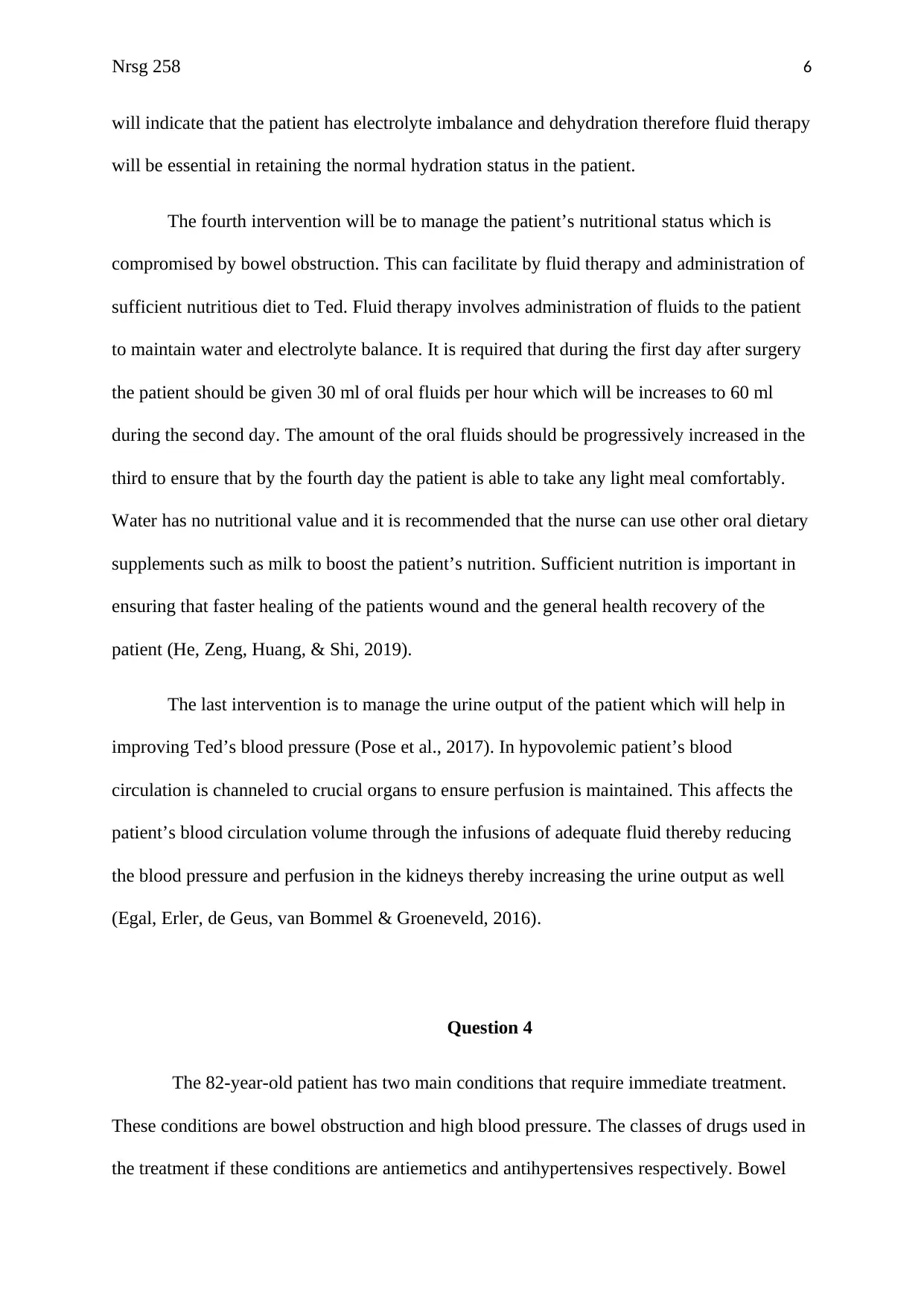
Nrsg 258 6
will indicate that the patient has electrolyte imbalance and dehydration therefore fluid therapy
will be essential in retaining the normal hydration status in the patient.
The fourth intervention will be to manage the patient’s nutritional status which is
compromised by bowel obstruction. This can facilitate by fluid therapy and administration of
sufficient nutritious diet to Ted. Fluid therapy involves administration of fluids to the patient
to maintain water and electrolyte balance. It is required that during the first day after surgery
the patient should be given 30 ml of oral fluids per hour which will be increases to 60 ml
during the second day. The amount of the oral fluids should be progressively increased in the
third to ensure that by the fourth day the patient is able to take any light meal comfortably.
Water has no nutritional value and it is recommended that the nurse can use other oral dietary
supplements such as milk to boost the patient’s nutrition. Sufficient nutrition is important in
ensuring that faster healing of the patients wound and the general health recovery of the
patient (He, Zeng, Huang, & Shi, 2019).
The last intervention is to manage the urine output of the patient which will help in
improving Ted’s blood pressure (Pose et al., 2017). In hypovolemic patient’s blood
circulation is channeled to crucial organs to ensure perfusion is maintained. This affects the
patient’s blood circulation volume through the infusions of adequate fluid thereby reducing
the blood pressure and perfusion in the kidneys thereby increasing the urine output as well
(Egal, Erler, de Geus, van Bommel & Groeneveld, 2016).
Question 4
The 82-year-old patient has two main conditions that require immediate treatment.
These conditions are bowel obstruction and high blood pressure. The classes of drugs used in
the treatment if these conditions are antiemetics and antihypertensives respectively. Bowel
will indicate that the patient has electrolyte imbalance and dehydration therefore fluid therapy
will be essential in retaining the normal hydration status in the patient.
The fourth intervention will be to manage the patient’s nutritional status which is
compromised by bowel obstruction. This can facilitate by fluid therapy and administration of
sufficient nutritious diet to Ted. Fluid therapy involves administration of fluids to the patient
to maintain water and electrolyte balance. It is required that during the first day after surgery
the patient should be given 30 ml of oral fluids per hour which will be increases to 60 ml
during the second day. The amount of the oral fluids should be progressively increased in the
third to ensure that by the fourth day the patient is able to take any light meal comfortably.
Water has no nutritional value and it is recommended that the nurse can use other oral dietary
supplements such as milk to boost the patient’s nutrition. Sufficient nutrition is important in
ensuring that faster healing of the patients wound and the general health recovery of the
patient (He, Zeng, Huang, & Shi, 2019).
The last intervention is to manage the urine output of the patient which will help in
improving Ted’s blood pressure (Pose et al., 2017). In hypovolemic patient’s blood
circulation is channeled to crucial organs to ensure perfusion is maintained. This affects the
patient’s blood circulation volume through the infusions of adequate fluid thereby reducing
the blood pressure and perfusion in the kidneys thereby increasing the urine output as well
(Egal, Erler, de Geus, van Bommel & Groeneveld, 2016).
Question 4
The 82-year-old patient has two main conditions that require immediate treatment.
These conditions are bowel obstruction and high blood pressure. The classes of drugs used in
the treatment if these conditions are antiemetics and antihypertensives respectively. Bowel
⊘ This is a preview!⊘
Do you want full access?
Subscribe today to unlock all pages.

Trusted by 1+ million students worldwide
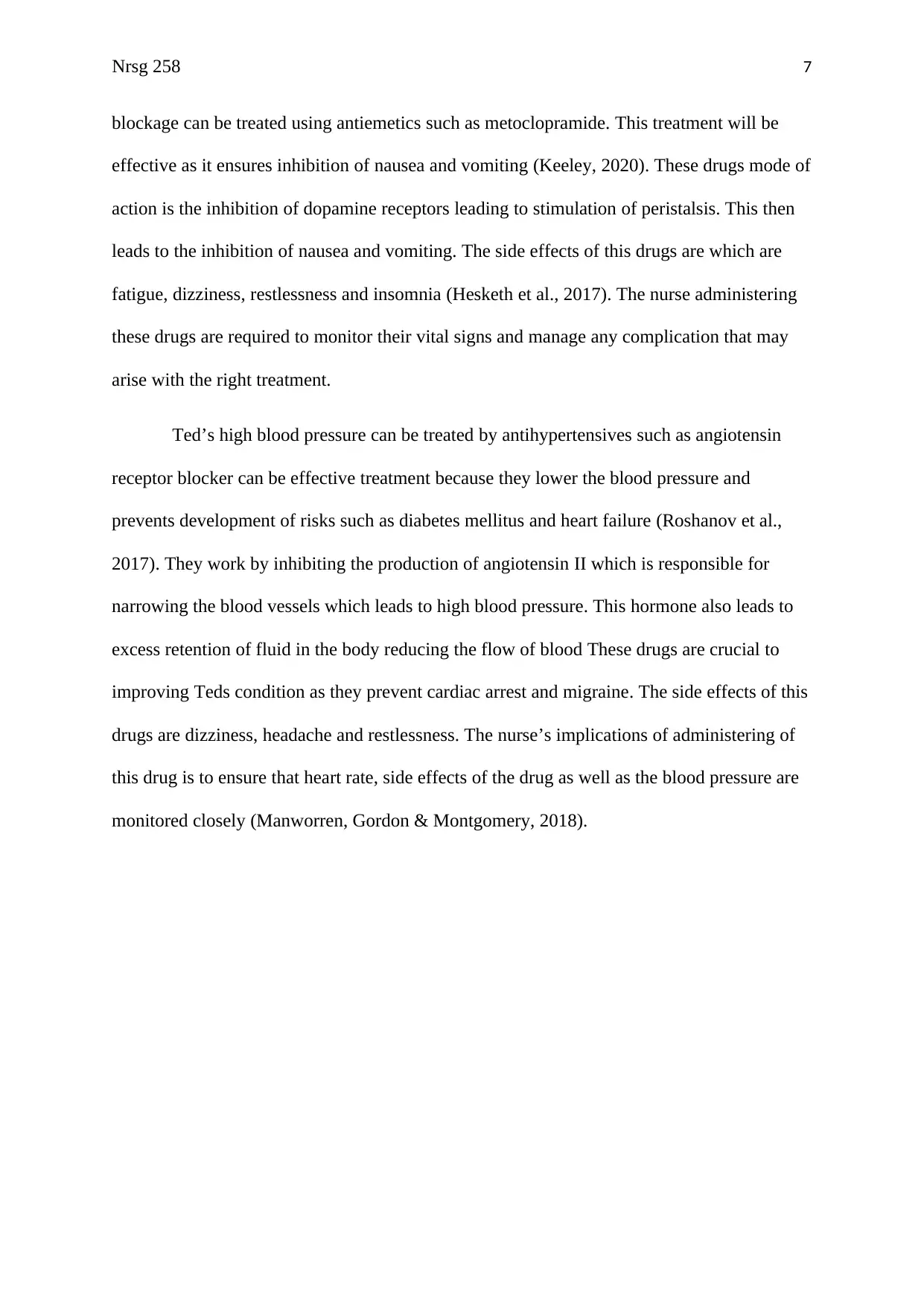
Nrsg 258 7
blockage can be treated using antiemetics such as metoclopramide. This treatment will be
effective as it ensures inhibition of nausea and vomiting (Keeley, 2020). These drugs mode of
action is the inhibition of dopamine receptors leading to stimulation of peristalsis. This then
leads to the inhibition of nausea and vomiting. The side effects of this drugs are which are
fatigue, dizziness, restlessness and insomnia (Hesketh et al., 2017). The nurse administering
these drugs are required to monitor their vital signs and manage any complication that may
arise with the right treatment.
Ted’s high blood pressure can be treated by antihypertensives such as angiotensin
receptor blocker can be effective treatment because they lower the blood pressure and
prevents development of risks such as diabetes mellitus and heart failure (Roshanov et al.,
2017). They work by inhibiting the production of angiotensin II which is responsible for
narrowing the blood vessels which leads to high blood pressure. This hormone also leads to
excess retention of fluid in the body reducing the flow of blood These drugs are crucial to
improving Teds condition as they prevent cardiac arrest and migraine. The side effects of this
drugs are dizziness, headache and restlessness. The nurse’s implications of administering of
this drug is to ensure that heart rate, side effects of the drug as well as the blood pressure are
monitored closely (Manworren, Gordon & Montgomery, 2018).
blockage can be treated using antiemetics such as metoclopramide. This treatment will be
effective as it ensures inhibition of nausea and vomiting (Keeley, 2020). These drugs mode of
action is the inhibition of dopamine receptors leading to stimulation of peristalsis. This then
leads to the inhibition of nausea and vomiting. The side effects of this drugs are which are
fatigue, dizziness, restlessness and insomnia (Hesketh et al., 2017). The nurse administering
these drugs are required to monitor their vital signs and manage any complication that may
arise with the right treatment.
Ted’s high blood pressure can be treated by antihypertensives such as angiotensin
receptor blocker can be effective treatment because they lower the blood pressure and
prevents development of risks such as diabetes mellitus and heart failure (Roshanov et al.,
2017). They work by inhibiting the production of angiotensin II which is responsible for
narrowing the blood vessels which leads to high blood pressure. This hormone also leads to
excess retention of fluid in the body reducing the flow of blood These drugs are crucial to
improving Teds condition as they prevent cardiac arrest and migraine. The side effects of this
drugs are dizziness, headache and restlessness. The nurse’s implications of administering of
this drug is to ensure that heart rate, side effects of the drug as well as the blood pressure are
monitored closely (Manworren, Gordon & Montgomery, 2018).
Paraphrase This Document
Need a fresh take? Get an instant paraphrase of this document with our AI Paraphraser
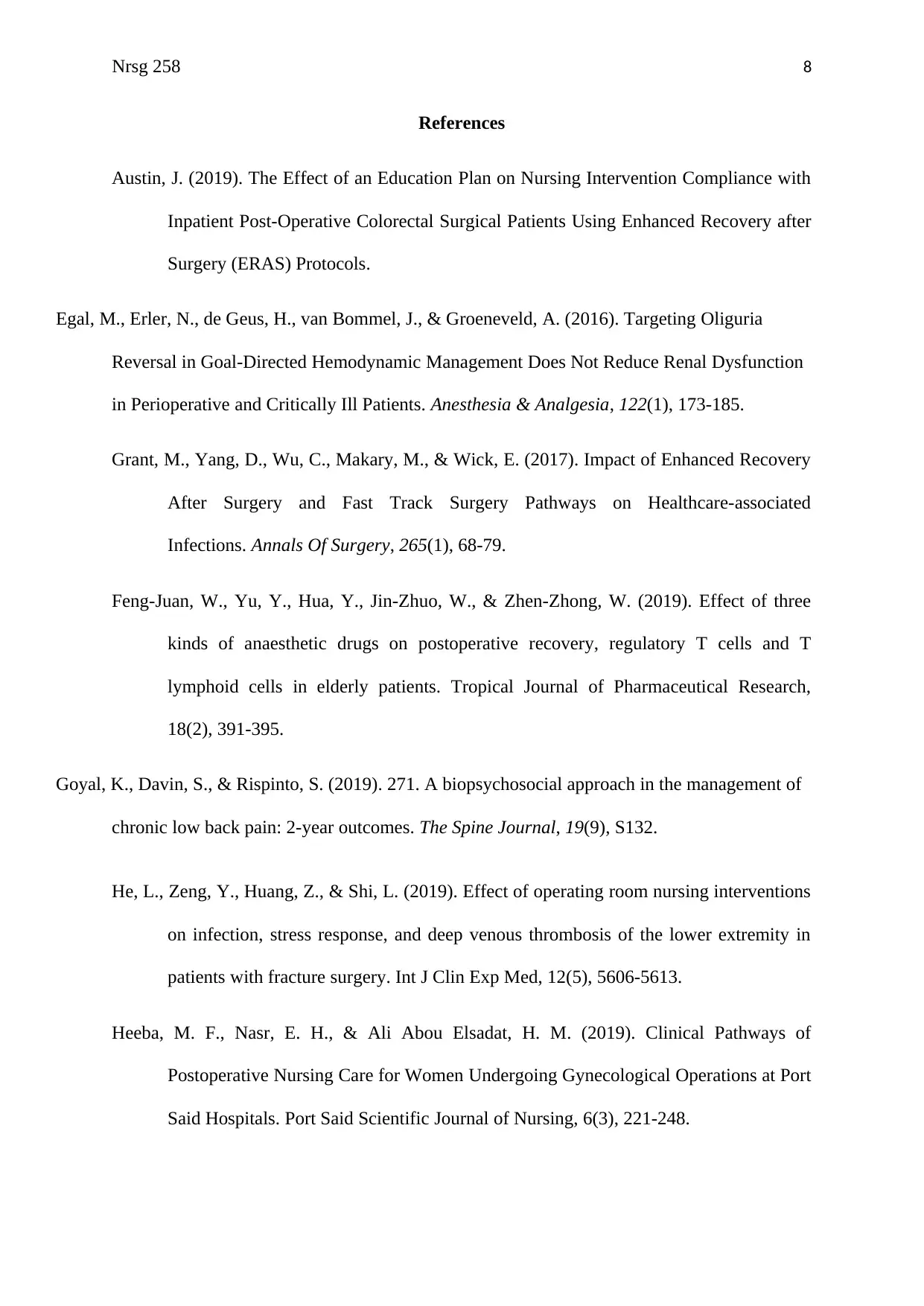
Nrsg 258 8
References
Austin, J. (2019). The Effect of an Education Plan on Nursing Intervention Compliance with
Inpatient Post-Operative Colorectal Surgical Patients Using Enhanced Recovery after
Surgery (ERAS) Protocols.
Egal, M., Erler, N., de Geus, H., van Bommel, J., & Groeneveld, A. (2016). Targeting Oliguria
Reversal in Goal-Directed Hemodynamic Management Does Not Reduce Renal Dysfunction
in Perioperative and Critically Ill Patients. Anesthesia & Analgesia, 122(1), 173-185.
Grant, M., Yang, D., Wu, C., Makary, M., & Wick, E. (2017). Impact of Enhanced Recovery
After Surgery and Fast Track Surgery Pathways on Healthcare-associated
Infections. Annals Of Surgery, 265(1), 68-79.
Feng-Juan, W., Yu, Y., Hua, Y., Jin-Zhuo, W., & Zhen-Zhong, W. (2019). Effect of three
kinds of anaesthetic drugs on postoperative recovery, regulatory T cells and T
lymphoid cells in elderly patients. Tropical Journal of Pharmaceutical Research,
18(2), 391-395.
Goyal, K., Davin, S., & Rispinto, S. (2019). 271. A biopsychosocial approach in the management of
chronic low back pain: 2-year outcomes. The Spine Journal, 19(9), S132.
He, L., Zeng, Y., Huang, Z., & Shi, L. (2019). Effect of operating room nursing interventions
on infection, stress response, and deep venous thrombosis of the lower extremity in
patients with fracture surgery. Int J Clin Exp Med, 12(5), 5606-5613.
Heeba, M. F., Nasr, E. H., & Ali Abou Elsadat, H. M. (2019). Clinical Pathways of
Postoperative Nursing Care for Women Undergoing Gynecological Operations at Port
Said Hospitals. Port Said Scientific Journal of Nursing, 6(3), 221-248.
References
Austin, J. (2019). The Effect of an Education Plan on Nursing Intervention Compliance with
Inpatient Post-Operative Colorectal Surgical Patients Using Enhanced Recovery after
Surgery (ERAS) Protocols.
Egal, M., Erler, N., de Geus, H., van Bommel, J., & Groeneveld, A. (2016). Targeting Oliguria
Reversal in Goal-Directed Hemodynamic Management Does Not Reduce Renal Dysfunction
in Perioperative and Critically Ill Patients. Anesthesia & Analgesia, 122(1), 173-185.
Grant, M., Yang, D., Wu, C., Makary, M., & Wick, E. (2017). Impact of Enhanced Recovery
After Surgery and Fast Track Surgery Pathways on Healthcare-associated
Infections. Annals Of Surgery, 265(1), 68-79.
Feng-Juan, W., Yu, Y., Hua, Y., Jin-Zhuo, W., & Zhen-Zhong, W. (2019). Effect of three
kinds of anaesthetic drugs on postoperative recovery, regulatory T cells and T
lymphoid cells in elderly patients. Tropical Journal of Pharmaceutical Research,
18(2), 391-395.
Goyal, K., Davin, S., & Rispinto, S. (2019). 271. A biopsychosocial approach in the management of
chronic low back pain: 2-year outcomes. The Spine Journal, 19(9), S132.
He, L., Zeng, Y., Huang, Z., & Shi, L. (2019). Effect of operating room nursing interventions
on infection, stress response, and deep venous thrombosis of the lower extremity in
patients with fracture surgery. Int J Clin Exp Med, 12(5), 5606-5613.
Heeba, M. F., Nasr, E. H., & Ali Abou Elsadat, H. M. (2019). Clinical Pathways of
Postoperative Nursing Care for Women Undergoing Gynecological Operations at Port
Said Hospitals. Port Said Scientific Journal of Nursing, 6(3), 221-248.
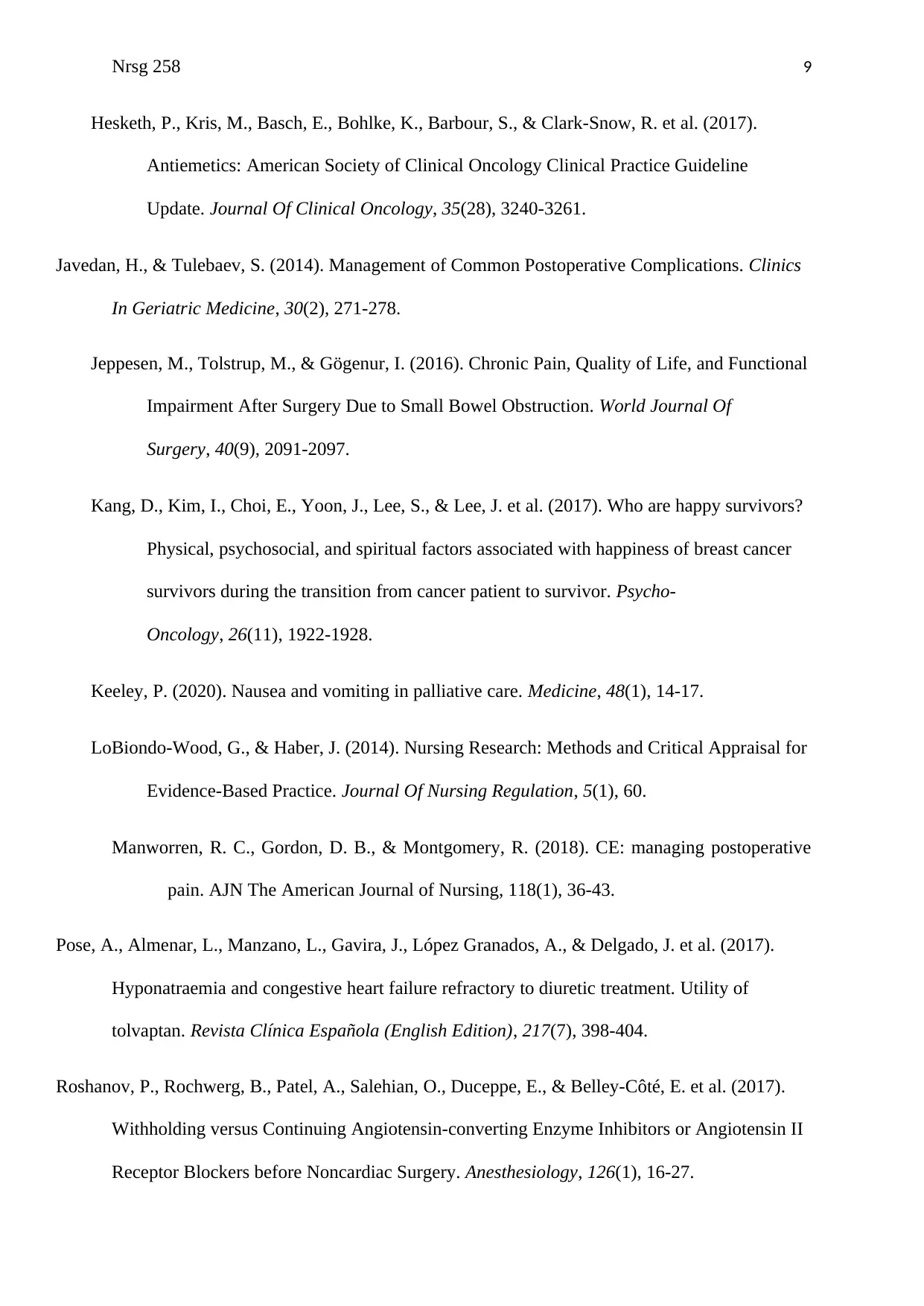
Nrsg 258 9
Hesketh, P., Kris, M., Basch, E., Bohlke, K., Barbour, S., & Clark-Snow, R. et al. (2017).
Antiemetics: American Society of Clinical Oncology Clinical Practice Guideline
Update. Journal Of Clinical Oncology, 35(28), 3240-3261.
Javedan, H., & Tulebaev, S. (2014). Management of Common Postoperative Complications. Clinics
In Geriatric Medicine, 30(2), 271-278.
Jeppesen, M., Tolstrup, M., & Gögenur, I. (2016). Chronic Pain, Quality of Life, and Functional
Impairment After Surgery Due to Small Bowel Obstruction. World Journal Of
Surgery, 40(9), 2091-2097.
Kang, D., Kim, I., Choi, E., Yoon, J., Lee, S., & Lee, J. et al. (2017). Who are happy survivors?
Physical, psychosocial, and spiritual factors associated with happiness of breast cancer
survivors during the transition from cancer patient to survivor. Psycho-
Oncology, 26(11), 1922-1928.
Keeley, P. (2020). Nausea and vomiting in palliative care. Medicine, 48(1), 14-17.
LoBiondo-Wood, G., & Haber, J. (2014). Nursing Research: Methods and Critical Appraisal for
Evidence-Based Practice. Journal Of Nursing Regulation, 5(1), 60.
Manworren, R. C., Gordon, D. B., & Montgomery, R. (2018). CE: managing postoperative
pain. AJN The American Journal of Nursing, 118(1), 36-43.
Pose, A., Almenar, L., Manzano, L., Gavira, J., López Granados, A., & Delgado, J. et al. (2017).
Hyponatraemia and congestive heart failure refractory to diuretic treatment. Utility of
tolvaptan. Revista Clínica Española (English Edition), 217(7), 398-404.
Roshanov, P., Rochwerg, B., Patel, A., Salehian, O., Duceppe, E., & Belley-Côté, E. et al. (2017).
Withholding versus Continuing Angiotensin-converting Enzyme Inhibitors or Angiotensin II
Receptor Blockers before Noncardiac Surgery. Anesthesiology, 126(1), 16-27.
Hesketh, P., Kris, M., Basch, E., Bohlke, K., Barbour, S., & Clark-Snow, R. et al. (2017).
Antiemetics: American Society of Clinical Oncology Clinical Practice Guideline
Update. Journal Of Clinical Oncology, 35(28), 3240-3261.
Javedan, H., & Tulebaev, S. (2014). Management of Common Postoperative Complications. Clinics
In Geriatric Medicine, 30(2), 271-278.
Jeppesen, M., Tolstrup, M., & Gögenur, I. (2016). Chronic Pain, Quality of Life, and Functional
Impairment After Surgery Due to Small Bowel Obstruction. World Journal Of
Surgery, 40(9), 2091-2097.
Kang, D., Kim, I., Choi, E., Yoon, J., Lee, S., & Lee, J. et al. (2017). Who are happy survivors?
Physical, psychosocial, and spiritual factors associated with happiness of breast cancer
survivors during the transition from cancer patient to survivor. Psycho-
Oncology, 26(11), 1922-1928.
Keeley, P. (2020). Nausea and vomiting in palliative care. Medicine, 48(1), 14-17.
LoBiondo-Wood, G., & Haber, J. (2014). Nursing Research: Methods and Critical Appraisal for
Evidence-Based Practice. Journal Of Nursing Regulation, 5(1), 60.
Manworren, R. C., Gordon, D. B., & Montgomery, R. (2018). CE: managing postoperative
pain. AJN The American Journal of Nursing, 118(1), 36-43.
Pose, A., Almenar, L., Manzano, L., Gavira, J., López Granados, A., & Delgado, J. et al. (2017).
Hyponatraemia and congestive heart failure refractory to diuretic treatment. Utility of
tolvaptan. Revista Clínica Española (English Edition), 217(7), 398-404.
Roshanov, P., Rochwerg, B., Patel, A., Salehian, O., Duceppe, E., & Belley-Côté, E. et al. (2017).
Withholding versus Continuing Angiotensin-converting Enzyme Inhibitors or Angiotensin II
Receptor Blockers before Noncardiac Surgery. Anesthesiology, 126(1), 16-27.
⊘ This is a preview!⊘
Do you want full access?
Subscribe today to unlock all pages.

Trusted by 1+ million students worldwide
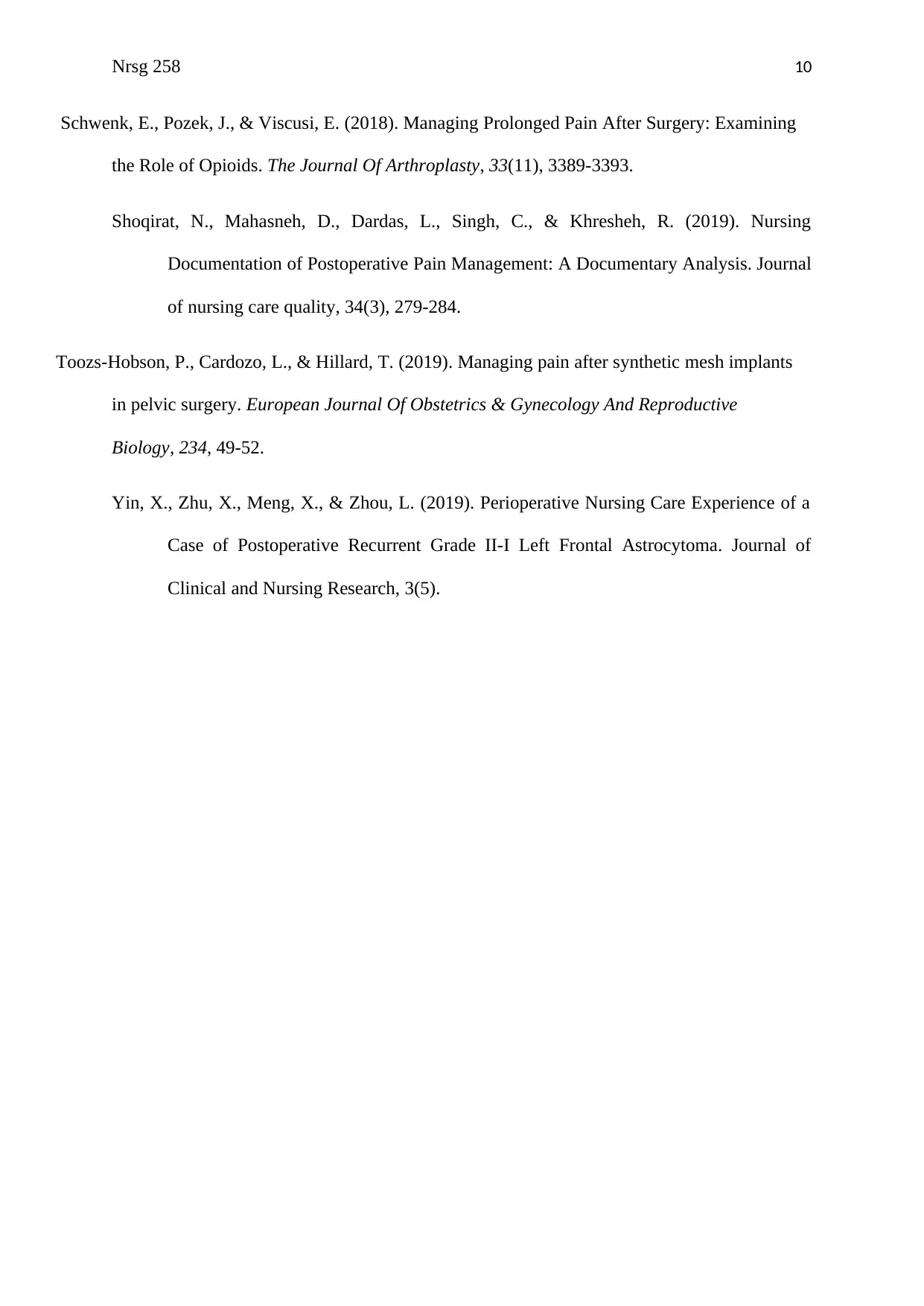
Nrsg 258 10
Schwenk, E., Pozek, J., & Viscusi, E. (2018). Managing Prolonged Pain After Surgery: Examining
the Role of Opioids. The Journal Of Arthroplasty, 33(11), 3389-3393.
Shoqirat, N., Mahasneh, D., Dardas, L., Singh, C., & Khresheh, R. (2019). Nursing
Documentation of Postoperative Pain Management: A Documentary Analysis. Journal
of nursing care quality, 34(3), 279-284.
Toozs-Hobson, P., Cardozo, L., & Hillard, T. (2019). Managing pain after synthetic mesh implants
in pelvic surgery. European Journal Of Obstetrics & Gynecology And Reproductive
Biology, 234, 49-52.
Yin, X., Zhu, X., Meng, X., & Zhou, L. (2019). Perioperative Nursing Care Experience of a
Case of Postoperative Recurrent Grade II-I Left Frontal Astrocytoma. Journal of
Clinical and Nursing Research, 3(5).
Schwenk, E., Pozek, J., & Viscusi, E. (2018). Managing Prolonged Pain After Surgery: Examining
the Role of Opioids. The Journal Of Arthroplasty, 33(11), 3389-3393.
Shoqirat, N., Mahasneh, D., Dardas, L., Singh, C., & Khresheh, R. (2019). Nursing
Documentation of Postoperative Pain Management: A Documentary Analysis. Journal
of nursing care quality, 34(3), 279-284.
Toozs-Hobson, P., Cardozo, L., & Hillard, T. (2019). Managing pain after synthetic mesh implants
in pelvic surgery. European Journal Of Obstetrics & Gynecology And Reproductive
Biology, 234, 49-52.
Yin, X., Zhu, X., Meng, X., & Zhou, L. (2019). Perioperative Nursing Care Experience of a
Case of Postoperative Recurrent Grade II-I Left Frontal Astrocytoma. Journal of
Clinical and Nursing Research, 3(5).
Paraphrase This Document
Need a fresh take? Get an instant paraphrase of this document with our AI Paraphraser

Nrsg 258 11

Nrsg 258 12
⊘ This is a preview!⊘
Do you want full access?
Subscribe today to unlock all pages.

Trusted by 1+ million students worldwide
1 out of 12
Related Documents
Your All-in-One AI-Powered Toolkit for Academic Success.
+13062052269
info@desklib.com
Available 24*7 on WhatsApp / Email
![[object Object]](/_next/static/media/star-bottom.7253800d.svg)
Unlock your academic potential
Copyright © 2020–2025 A2Z Services. All Rights Reserved. Developed and managed by ZUCOL.




